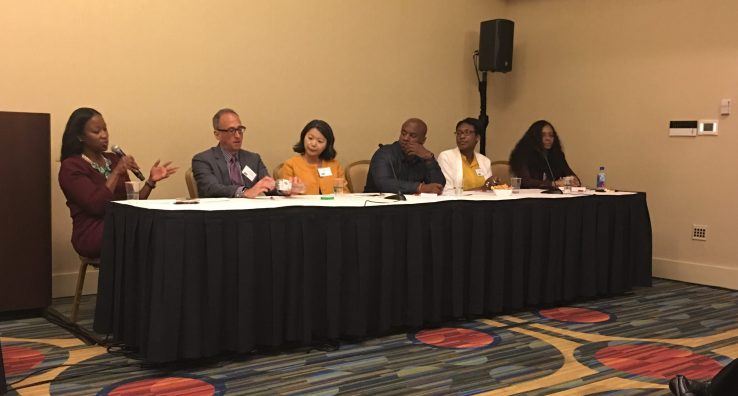

Tech’s freshman class of diversity and inclusion leaders gathered at Rev. Jesse Jackson’s PUSHTech 2020 conference today to answer the question, “What now?”
Within the last six months, Dropbox, Pinterest, Airbnb, Twitter and Intuit have all hired employees charged with correcting their diversity problems. At Jackson’s conference, intended to increase diversity in tech, those newly minted leaders are determining their path forward.
The first step, as addiction counselors say, is admitting you have a problem. Most industry-leading companies have already made that first uncomfortable admission in the past year, releasing statistics on the lack of women and people of color in their workforces. Now, instead of transparency reports, the trend has shifted to hiring diversity chiefs to fix the problem — preferably from within the communities these leaders will be tasked to represent.
The big change tech needs is a cultural one — and it seems that diversity chiefs are still figuring out how to make it happen.
Dropbox has had Judith Williams as its global head of diversity since October; Pinterest added Candice Morgan as head of diversity three months ago; Airbnb hired David King as director of diversity less than two months ago, Jeffrey Siminoff joined Twitter as vice president of inclusion and diversity four months ago, and Michelle Angier has been chief diversity officer at Intuit since December.
Seeing a new class of diversity leaders hired across the industry feels good, but the big question is what comes next. Unfortunately for data-driven executives, the answer is more nebulous than just getting better percentages out of recruiting and hiring programs. The big change tech needs is a cultural one — and it seems that diversity chiefs are still figuring out how to make it happen.
The most urgent task, of course, is boosting their companies’ embarrassingly low percentages of minority employees. But a hiring surge alone isn’t enough to trigger a culture shift — and fixing the culture that allows women engineers to be harassed out of their jobs or managers to suggest building a tool to guess the ethnicity of job applicants by their last names will take more than just a fresh group of new hires.
To get employees to stick around, diversity leaders are focusing on inclusion.
“I like to think of it as, inclusion is diversity sustained,” says Candice Morgan. It means nothing for companies to bring in a group of diverse new hires if those people turn around and leave when confronted with an unwelcoming culture, Morgan explains.
Morgan and her peers say they’re using a mix of employee resource groups, unconscious bias training, and ally outreach to keep diverse employees from leaving. But there’s still so much more to be done, says Airbnb’s David King.
“One of the first conversations [at Airbnb] was about women in tech,” King explained. “But people weren’t talking about race. Disability wasn’t mentioned at all.”
There’s resistance among legacy employees who worry they’ll be excluded or that they don’t have the knowledge base to comfortably join a conversation about diversity. Some employees feel like they don’t fit in with the left-leaning politics in their workspaces — King cited the example of a Trump-supporting Airbnb employee who felt excluded from workplace chatter about politics.
Even after all the culture work is done, diversity leaders still don’t think they’ll have convinced everyone in their organizations to be more inclusive.
Judith Williams says she believes 10-15 percent of Dropbox’s employees will never be supportive of her diversity mission. But, she adds, if she can get support from employees who are invested in diversity or neutral on the subject, “You can create a culture where those who will never support you have to be quiet about it.”
Diversity heads are beginning to look beyond their employees as well. Although users might not be concerned about the diversity of the engineers who build their favorite products, those engineers are encouraged to consider the diversity of their users.
One of the first conversations [at Airbnb] was about women in tech. But people weren’t talking about race. Disability wasn’t mentioned at all.
Airbnb wants its customers to see it as a company that provides an important economic opportunity to black communities, not as a company that enables hosts to discriminate against travelers with African-American names.
Twitter wants to be viewed as the company that helped amplify the Black Lives Matter movement, not as the place where female video game developers face a deluge of rape and death threats.
Even as change comes at these companies, the shift for users still seems aspirational.
The plans proposed today represent a strong industry-wide start at adjusting workplace culture. But, with all these diversity leaders still brand-new in their roles, it’s not clear how hard they can push for change.
At the end of today’s panel on diversity, an audience member stood up and asked the group if executive compensation was tied to corporate diversity goals. One by one, the panelists answered no.

